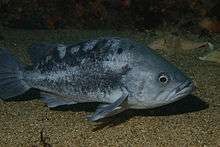Black rockfish
| Black rockfish | |
|---|---|
 | |
| A typical specimen. The white sides indicate it is of older age. | |
| Scientific classification | |
| Kingdom: | Animalia |
| Phylum: | Chordata |
| Class: | Actinopterygii |
| Order: | Scorpaeniformes |
| Family: | Sebastidae |
| Genus: | Sebastes |
| Species: | S. melanops |
| Binomial name | |
| Sebastes melanops Girard, 1856 | |
The black rockfish (Sebastes melanops, also known variously as the black seaperch, black bass, black rock cod, sea bass, black snapper, and Pacific Ocean perch)[1] is a rockfish of the genus Sebastes. It is sometimes misidentified as the "red snapper."[1]
The rockfish has a total of 8 weak head spines. It is originally all-black, but turns a mottled gray on the sides with age, often nearing white. It grows up to 25 in (64 cm) in length, and is found to a depth of 200 fathoms (366 m), though usually at the range of >83 fathoms (152 m).[2]
Rockfish is prime fishing game, and a reproductive rate unusually high for its slow-growing genus makes it more resistant to fishing than its cousins, such as the Yelloweye rockfish, are. They are harvested in Oregon, California, Washington, British Columbia, Alaska, and the Pacific. They are a fairly common catch along the West Coast of North America, where populations are stable.[1] Schools of adults often aggregate over rocky bottoms or at the sea surface, habits that make them susceptible to targeted fishing.[3]
Black rockfish are pelagic, that is, they occur on the continental shelf. Like other pelagic fish, they spend most of their time amid the water columns and are generally associated with rougher terra. This can make it somewhat inconvenient for commercial fisheries, which are often situated in nearshore, shallow water, and rocky areas (reefs). They make up an important component of nearshore fisheries in Southeastern Alaska.[3]
Rockfish are slow-growing and extremely long-lived, and black rockfish become sexually mature only after 6 to 8 years of age. Specimen collected off Alaska have been aged to 49 years old. In addition they benefit from a low natural mortality rate, at only about 7% of the total population.[3]
Black rockfish breed via internal fertilization, meaning that female members of the species store sperm until the development of the eggs. The phases between the start of the process and the end are separated by several months. The majority of the young are reared in late winter to early spring. Females produce between 125,000 and 1,200,000 eggs every breeding season. However it has been noted that not all of the eggs are released every year. It has been occasionally observed that the female may absorb the eggs back into her system.[3]
Tagging studies off Washington, Oregon, and Southeast Alaska indicate that although for the most part they spend most of their life in a small area, some long-distance travel does occur.[3]
References
- 1 2 3 "Rockfish, Black". Monterey Bay Aquarium Foundation. 2009. Archived from the original on 6 July 2010. Retrieved 14 December 2009.
- ↑ "Black rockfish (Sebastes melanops)". NOAA Office of Protected Resources. Retrieved 14 December 2009.
- 1 2 3 4 5 "Black Rockfish Species Profile: Southeast Alaska and Yakutat". Alaska Department of Fish and Game. June 11, 2009. Retrieved 14 December 2009.